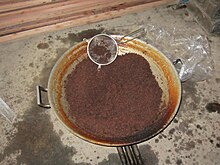Latik
 | |
| Type | Desserttopping |
|---|---|
| Place of origin | Philippines |


Latík(Tagalog:[laˈtɪk]) refers to two differentcoconut-based ingredients inFilipino cuisine.In theVisayan regionit refers to a syrupy caramelized coconut cream (coconut caramel) used as a dessert sauce.[1]In the northern Philippines, it refers to solid byproducts of coconut oil production (coconut curds), used asgarnishingfor a variety of desserts.
VisayanLatik[edit]
Latíkin its original sense in theVisayan languagesliterally means 'syrup' (equivalent toarnibalinHiligaynon). It can refer to any type of thick sweetened liquids includingjam.[2]In the most common usage, however,latikmeans a syrupycondimentderived from reducing coconut milk and sugar.[3][4]
It is used much in the same way as syrup, in dishes likekalamayandsuman.[5]It is usually Anglicized as "coconut caramel."[1]A commercial version of the Visayanlatikis marketed internationally ascoconut syrup,though it should not be confused withcoconut sugarderived from coconut sap.[6][7]
TagalogLatík[edit]
LatíkinLuzonis made fromcoconut milksimmered in a saucepan until it reduces tococonut oiland solids ( "coconut curds" ) begin to form at the top surface. These solids are left to fry in the coconut oil until golden brown.[8][9]In the Visayas, these solids are known aslunokin Cebuano; andbalutaiinKaray-a.[10]
Latíkis commonly used as topping for a variety of Philippine dishes includingmaja blanca,sapin-sapin,andube halaya.[11][12]
They are sometimes mistaken for fried caramelized coconut flesh (another type of garnishing/dessert known asbukayoinBisaya).[8]
See also[edit]
- Kalamay
- Coconut jam
- List of condiments
- List of dessert sauces
- List of Philippine dishes
- Maglalatik(literally "latikmaker "), an indigenous Philippine dance
- Philippine condiments
References[edit]
- ^abGoldstein, Darra (2015).The Oxford Companion to Sugar and Sweets.Oxford University Press. p. 530.ISBN9780199313396.
- ^"latik".Binisaya.RetrievedJuly 5,2011.
- ^"Bisaya translation for" latik "".Bisaya Translator and Cebuano Dictionary. Archived fromthe originalon August 11, 2013.RetrievedJuly 5,2011.
- ^"Philippine quarterly of culture and society".32.University of San Carlos. 2004: 31.
{{cite journal}}:Cite journal requires|journal=(help) - ^"Suman Latik".Lutong Bahay.RetrievedJuly 5,2011.
- ^Thampan, Palakasseril Kumaran (1981).Handbook on Coconut Palm.Oxford & IBH. p. 199.
- ^Grimwood, Brian E. (1975).Coconut Palm Products: Their Processing in Developing Countries.Food & Agriculture Organization. pp. 183–187.ISBN9789251008539.
- ^ab"Latik / Fried Coconut Milk Solids".Market Manila. August 5, 2008.RetrievedJuly 5,2011.
- ^Vanjo Merano (March 25, 2010)."How to Make Latik".Panlasang Pinoy.RetrievedJuly 5,2011.
- ^Edgie Polistico (2017).Philippine Food, Cooking, & Dining Dictionary.Anvil Publishing, Incorporated.ISBN9786214200870.
- ^Reynaldo G. Alejandro; Doreen G. Fernandez (1998).Food of the Philippines.Tuttle Publishing. p. 102.ISBN978-962-593-245-3.
- ^Philippines. Dept. of Education, Culture, and Sports (1989).Duyan ng magiting: the folk culture of the southern Tagalog region.Kalinangan series. Vol. 3. IMC.ISBN978-971-10-1241-0.
{{cite book}}:CS1 maint: multiple names: authors list (link)

